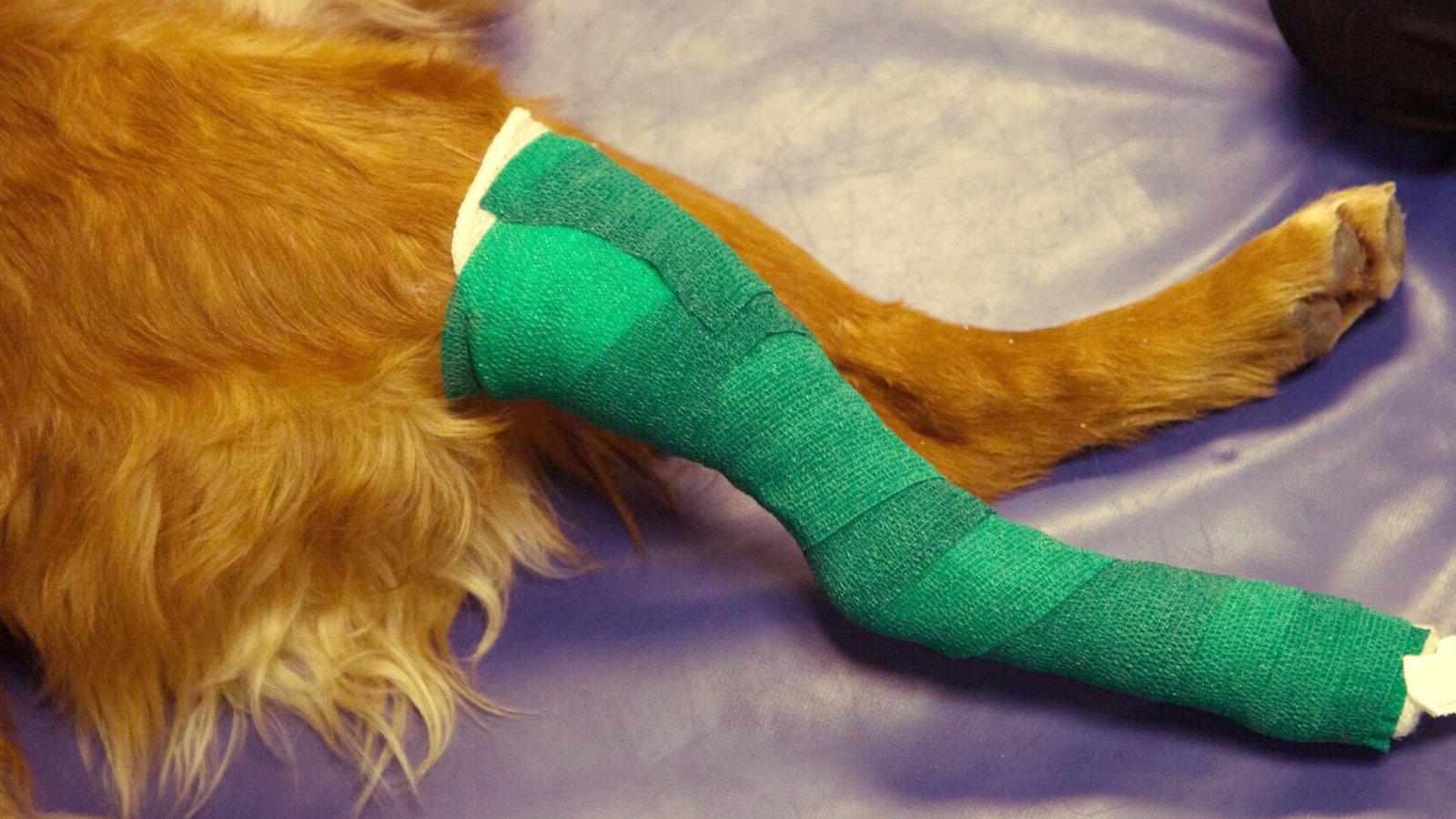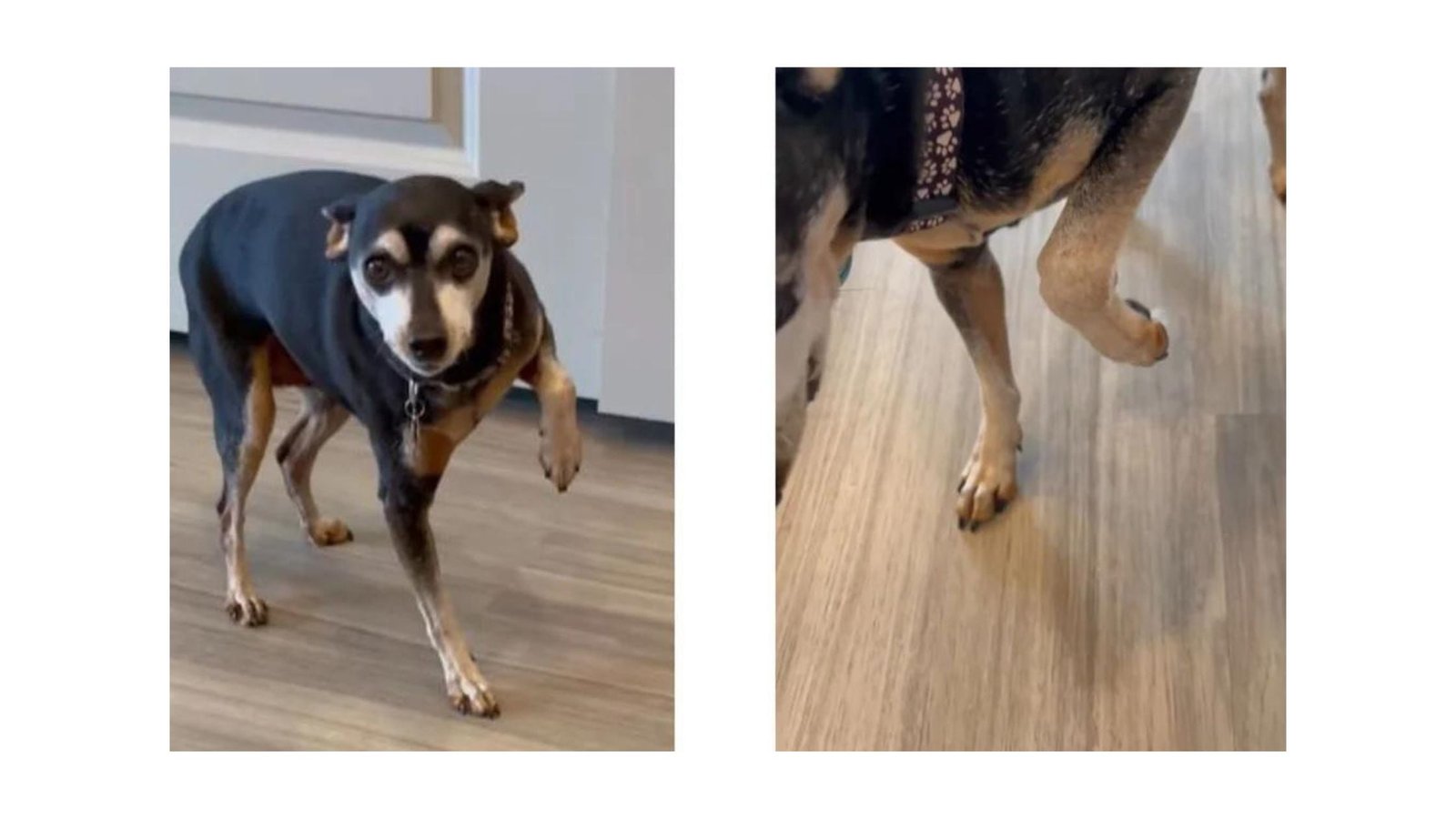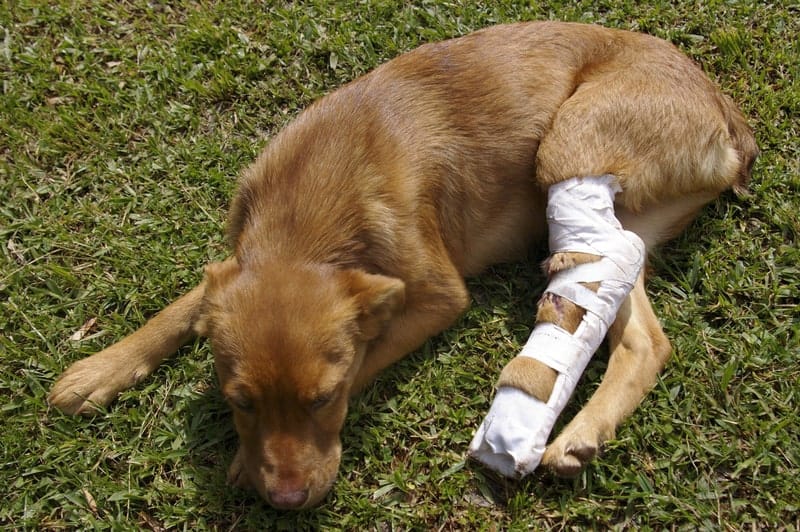Dogs, our loyal companions, are not immune to accidents and injuries. Among the various injuries that can occur, a broken back leg can be particularly distressing for both the dog and its owner. Read more about broken back legs in dogs!

THE REALITY OF BROKEN BACK LEGS IN DOGS
In this guide, we delve into the process of recovery for dogs with broken back legs, addressing common concerns and shedding light on the resilience and healing capacity of our four-legged friends.
Causes and Identifying Signs of a Broken Back Legs in Dogs
Dogs can break their back legs due to various reasons, including accidents, falls, or trauma. Understanding the causes helps in preventing such incidents and creating a safer environment for our dogs. Accidents can occur during play, walks, or even at home. Taking preventive measures, such as securing hazardous areas and providing a safe play environment, can significantly reduce the risk.
Recognizing the signs of a broken back leg is crucial for prompt intervention. Dogs may exhibit limping, swelling, or an unwillingness to put weight on the affected leg. Identifying these signs early can expedite the recovery process. Prompt veterinary attention is essential. If you notice any signs of discomfort or irregularity in your dog’s gait, seeking immediate medical assistance ensures a timely diagnosis and appropriate treatment plan.
Veterinary Care and Diagnosis for Broken Back Legs in Dogs
- Veterinary Evaluation and X-rays: Upon suspicion of a broken back leg, a veterinary evaluation is imperative. X-rays play a crucial role in confirming the diagnosis and determining the extent of the injury. Veterinarians use X-rays to assess the severity of the fracture and identify any additional complications. This information guides the formulation of an effective treatment plan.
- Treatment Options: Surgery vs. Conservative Management: The approach to treating a broken back leg depends on the severity of the fracture. Surgical intervention may be recommended for complex fractures, while less severe cases may be managed conservatively with the use of casts or splints. Surgical procedures involve the use of pins, plates, or screws to stabilize the fracture. Conservative management relies on immobilization through casts or splints, allowing the bone to heal over time.
Rehabilitation and Recovery for Broken Back Legs in Dogs
- Postoperative Care and Physical Therapy: After surgery, diligent postoperative care is crucial. Physical therapy, including controlled exercises and rehabilitation techniques, aids in restoring strength and mobility to the affected leg. Physical therapy helps prevent muscle atrophy and ensures a more complete and expedited recovery. Regular veterinary check-ups are essential to monitor progress and adjust the rehabilitation plan as needed.
- Nutrition and Supplements for Bone Health: Supporting the healing process from within is equally important. A balanced diet rich in nutrients, coupled with veterinarian-recommended supplements, promotes bone health and accelerates recovery. Nutrients like calcium, phosphorus, and vitamin D play a vital role in bone health. Consult with your veterinarian to determine the most appropriate diet and supplements for your dog’s specific needs.

REALISTIC EXPECTATIONS AND LONG-TERM CARE
Recovery from a broken back leg takes time, and patience is key. While dogs are remarkably resilient, expecting gradual improvement and setbacks is part of the healing journey. Dogs may need to relearn how to use the affected leg, and rehabilitation efforts should be consistent. Celebrate small victories and remain optimistic throughout the recovery period.
Patience in the Healing Process
Even after recovery, dogs may benefit from ongoing care and preventive measures to avoid future injuries. Regular exercise, a balanced diet, and a safe environment contribute to the overall well-being of your dog. Engaging in regular, low-impact exercises helps maintain muscle strength and joint flexibility. Preventive measures, such as providing supportive ramps and avoiding strenuous activities, safeguard against future accidents.
Recovering from a broken back leg is a gradual process that requires a combination of veterinary care, rehabilitation, and supportive measures. Dogs, known for their resilience, often amaze us with their ability to bounce back from injuries. As a responsible pet owner, being attuned to the signs of a broken back leg, seeking prompt veterinary care, and actively participating in your dog’s recovery journey contribute to a successful outcome.
Remember, each dog is unique, and a tailored approach to their care ensures the best possible chance of a full and robust recovery. Embrace the journey of healing, celebrate the milestones, and witness the indomitable spirit of your dog as they regain their mobility and zest for life.

PAWS FOR PREVENTION: AVOIDING FUTURE LEG INJURIES IN DOGS
As devoted pet owners, ensuring the well-being of our dogs is a top priority. One significant aspect of dog health involves taking proactive measures to prevent future leg injuries. Let’s explore strategies, lifestyle adjustments, and preventive measures aimed at safeguarding your dog’s legs from potential injuries. Let’s embark on a journey to promote dog well-being and minimize the risk of leg injuries.
Understanding Common Leg Injuries in Dogs
- Common Causes of Leg Injuries: To effectively prevent leg injuries, it’s essential to understand their common causes. Accidents, overexertion, and genetic predispositions can contribute to injuries such as sprains, strains, and ligament tears. Identifying potential risk factors allows pet owners to tailor preventive measures to their dog’s specific needs, reducing the likelihood of injuries.
- Dog Breed-Specific Considerations: Different dog breeds may have varying susceptibilities to leg injuries. Larger breeds may be prone to joint issues, while smaller breeds may face challenges related to fragile bones. Knowing your dog’s breed-specific vulnerabilities is crucial for effective prevention. Tailoring preventive strategies based on breed characteristics ensures a targeted and proactive approach to leg health.
Lifestyle Adjustments for Broken Back Legs Prevention in Dogs
- Maintaining a Healthy Weight: Weight management is a key factor in preventing leg injuries. Excess weight places additional strain on a dog’s joints, increasing the risk of injuries and exacerbating existing conditions. A balanced diet, portion control, and regular exercise contribute to weight management, promoting overall health and minimizing stress on the legs.
- Regular Exercise for Strength and Flexibility: Engaging in regular, moderate exercise is crucial for building and maintaining muscle strength and joint flexibility. Tailored exercise routines help condition your dog’s legs and reduce the risk of injuries. Consult with your veterinarian to create a suitable exercise plan that considers your dog’s age, breed, and overall health.
Creating a Safe Environment for Dogs
- Safe Play Areas and Surfaces: Ensuring a safe environment for play is essential in preventing accidental injuries. Designate secure play areas free of potential hazards, and choose surfaces that provide traction and minimize the risk of slips and falls. Grassy areas, rubberized mats, and carpeted spaces are examples of surfaces that offer good traction for dogs during play.
- Avoiding Strenuous Activities: While exercise is crucial, avoiding strenuous activities, especially for breeds prone to joint issues, is equally important. Limit high-impact activities like jumping from heights or abrupt stops during play. Consider alternative activities that provide mental and physical stimulation without placing excessive stress on your dog’s legs.
Protective Measures for Joint Health
- Joint Supplements: Incorporating joint supplements into your dog’s diet can be a proactive measure to support joint health. Glucosamine and chondroitin are commonly recommended supplements that contribute to maintaining joint integrity. Consult with your veterinarian to determine the appropriate supplements and dosage for your dog’s specific needs.
- Regular Vet Check-ups: Your veterinarian can assess your dog’s overall health, identify potential issues, and offer guidance on preventive measures specific to your dog’s breed and lifestyle. Early detection of potential concerns allows for timely intervention and minimizes the risk of future leg injuries.
Lifestyle Choices and Preventive Care
- Proper Warm-Up and Cool Down: Just as for humans, proper warm-up and cool-down routines are essential for preventing injuries in dogs. Gradual and controlled activity helps prepare the muscles and joints for exercise and aids in recovery afterward. Incorporating these routines into your dog’s exercise regimen can significantly contribute to injury prevention.
- Comfortable Resting Areas: Providing comfortable and supportive resting areas is often overlooked but crucial for preventing leg injuries. Orthopedic beds or supportive surfaces can alleviate pressure on joints, especially for dogs with existing conditions. Creating a cozy and supportive space encourages your dog to rest comfortably, promoting overall well-being. Preventing future leg injuries in dogs is a proactive and holistic endeavor that encompasses lifestyle adjustments, environmental considerations, and diligent preventive care.
By understanding your dog’s breed-specific needs, maintaining a healthy lifestyle, and being attentive to potential risks, you can significantly reduce the likelihood of leg injuries and promote the overall well-being of your furry companion. Remember, every dog is unique, and a personalized approach to preventive care ensures that your efforts are tailored to your dog’s specific requirements. Embrace the journey of canine health and well-being, and watch your four-legged friend thrive in a supportive and injury-resistant environment.

DOG COMFORT ZONE: ORTHOPEDIC BEDS FOR DOGS
Our beloved furry companions deserve the utmost comfort, especially when it comes to their rest and relaxation. For dogs, particularly those in their golden years or with specific health conditions, investing in an orthopedic bed can make a significant difference in their overall well-being. Let’s explore further into the world of orthopedic beds for dogs, shedding light on their benefits, how to choose the right one, and why they’re a game-changer for our dogs.
Understanding the Need for Orthopedic Beds
- Addressing Canine Joint Issues: Dogs, like humans, can experience joint issues, especially as they age. Orthopedic beds are designed to provide support to a dog’s joints, alleviating pain and discomfort associated with conditions like arthritis or hip dysplasia. Recognizing the signs of joint discomfort in your dog and addressing them with an orthopedic bed contributes to enhanced mobility and a better quality of life.
- Senior Dogs and Preventive Comfort: As dogs age, their bodies undergo changes that may impact their comfort during rest. Orthopedic beds serve as preventive measures, offering the necessary support to reduce the risk of developing joint problems and ensuring a comfortable place for senior dogs to rest. Choosing an orthopedic bed for your senior dog is a proactive step in maintaining their overall health and well-being.
Benefits of Orthopedic Beds for Dogs
- Pressure Point Relief: One of the primary benefits of orthopedic beds is their ability to provide pressure point relief. The memory foam or supportive materials used in these beds mold to the dog’s body, distributing weight evenly and reducing stress on joints. Dogs with arthritis or other joint conditions benefit greatly from beds that minimize pressure on sensitive areas, promoting a more restful sleep.
- Improved Sleep Quality: Sleep is very important for your dog’s overall health. Orthopedic beds contribute to improved sleep quality by offering a comfortable and supportive surface. Dogs experience less tossing and turning, resulting in deeper and more rejuvenating rest. Restful sleep is especially crucial for dogs recovering from surgery or dealing with chronic conditions, allowing for optimal healing.

CHOOSING THE RIGHT ORTHOPEDIC BED FOR DOGS
When selecting an orthopedic bed, consider your dog’s size and weight. Choosing an appropriately sized bed with adequate thickness ensures proper support and comfort. Larger breeds may require thicker beds to support their weight, while smaller breeds benefit from beds that provide ample cushioning.
Appropriate Size and Thickness
- Waterproof and Easy-to-Clean Features: Dogs, especially those with health conditions, may have accidents. Opting for an orthopedic bed with waterproof or water-resistant features makes clean-up a breeze and ensures a hygienic resting space for your furry friend. These features are particularly valuable for dogs with incontinence issues or those prone to spills and messes.
- Non-Skid Bottoms for Stability: Dogs can be enthusiastic when it comes to settling into their beds. Beds with non-skid bottoms provide stability, preventing the bed from sliding or shifting, especially on slippery surfaces. Stability is crucial for dogs with mobility issues or those who may struggle to get in and out of their beds.
Making the Transition to an Orthopedic Bed
- Introducing the Bed Gradually: Dogs may take some time to adjust to a new bed, especially if they have been using a different type of bed or surface. Introduce the orthopedic bed gradually, allowing your dog to associate it with positive experiences. Using treats, toys, and praise can create a positive association, making the transition smoother for your dog.
- Observing and Adapting: Pay attention to your dog’s behavior and comfort level with the new bed. If they seem hesitant or uncomfortable, consider adding familiar items like their favorite blanket or toy to make the bed more inviting. Dogs may have individual preferences, and adapting the bed to suit their comfort is key to ensuring its effectiveness.
Brief sum up about broken back legs in dogs
Orthopedic beds for dogs are more than just comfortable resting places; they are essential tools in promoting dog health and well-being. Understanding the benefits, choosing the right bed, and making a gradual transition can transform your dog’s rest experience and contribute to their overall quality of life.
Investing in an orthopedic bed is an act of love, providing your loyal companion with the support they need, especially as they age or face joint challenges. With the right orthopedic bed, you’re not just giving your dog a place to rest – you’re offering them a haven of comfort and care.
If you want to learn more about Canine degenerative myelopathy,
continue reading the Wiki Pages on this topic!



